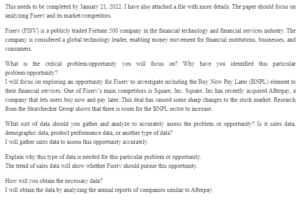Framing the Problem/Opportunity
Market conditions
Online shopping is a significant mode of transaction between merchants and clients. However, most online shoppers add items to their cart and then abandon them without checking out. This affects the conversion rate and signals a need for comprehensive payments for such purchases. Based on the SWOT analysis, the gap between cart abandonment and conversion serves as an opportunity for innovation. Clients using the Buy Now Pay Later card will be able to pay for products in installments that do not attract any interest. This financial solution is motivated by the high likelihood or rate of cart abandonment after shopping on online websites. When clients pay in installments, they can budget for their expenditures better and ensure a high rate of convFiserv online shops. Clients can now make their payments in four installments that are to be completed over six weeks. Following this announcement, numerous online merchants have reported higher rates of conversion, which have increased by at least 20 percent. In addition, the value of new orders has risen to 60 percent (Pavithra, 2020).
Square Inc. is one of Fiserv’s main competitors. Square, Inc. has recently acquired Afterpay, a company that allows users to buy now and pay later (AfterPay, 2022). This deal has caused some sharp changes to the stock market. Research from the Straw Hecker Group shows room for growth in the BNPL sector. This strategic move by Square Inc., which is a threat to Fiserv, shows the potential of the BNPL model of financing retail purchases. The financial solution also intrigues players and users because it benefits not only the consumers but also the merchants, who have an easy time obtaining authorization for clients who would like to use the financing option from the banks (PaymentsJournal, 2022). This creates confidence that the clients will honor the payment agreements to maintain a favorable credit rating. The main challenges associated with such competition are trying to retain the market share and convincing new clients that Fiserv’s BNPL card is better than AfterPay. The other threat is a possible high rate of default among clients, which may cause merchants to decline payments using the card. Hazards in the external environment include inflation, regulations, and unemployment. These factors can increase the rate of default (PaymentsJournal, 2022).
Problem/opportunity statement
Fiserv, a market leader in the provision of technology solutions and financial services, introduced a credit card dubbed ‘Buy Now Pay Later’ (BNPL) (Fiserv Inc., 2022). The card is expected to offer clients an opportunity to make partial payments for products purchased online.
The key metrics include sales, conversion rate, cart abandonment rate, percentage sales made using the BNPL card, and the number of people who have signed up for the card. While studying the issue at hand, the main stakeholders include online merchants, clients using the card, online shoppers, financial institutions, and Square Inc., the main competitor. The involvement of these stakeholders is critical in revealing data about the acceptance of the card, reasons for failing to use it, the amounts that people accrue using the card, the change in volume of sales, the rate of default, and the ability to match credit rating to a higher likelihood to pay, in addition, Fiserv will understand the demographics that it serves as well as those who opt for the competitor.
Currently, BNPL enjoys a 2.1 percent market share globally. The largest age group in Australia is 25-34 years, comprising 33.5 percent. The 35-49 years age group shall consist of 29.8 percent, while under 25 years constitute 22.4 percent. Its fast global adoption indicates acceptance in the market as credit card use drops significantly (de Best, 2021).
References
AfterPay. (2022). Shop now, pay later. Retrieved from AfterPay: https://www.afterpay.nl/en/
de Best, R. (2021). Buy Now, Pay Later (BNPL) – statistics & facts. Retrieved from Statista: https://www.statista.com/topics/8107/buy-now-pay-later-bnpl/#dossierKeyfigures
Fiserv Inc. (2022). Credit & Debit Solutions. Retrieved from Fiserv: https://www.fiserv.com/en/solutions/processing-services/credit-and-debit-solutions.html
Pavithra, R. (2020). Fiserv introduces the “Buy Now, Pay Later” installment payment option. Retrieved from IBS Intelligence: https://ibsintelligence.com/ibsi-news/fiserv-introduces-buy-now-pay-later-installment-payment-option/
PaymentsJournal. (2022). The Juggernaut Continues: Why Banks Should Make Moves into BNPL. PaymentsJournal. Retrieved from https://www.paymentsjournal.com/the-juggernaut-continues-why-banks-should-make-moves-into-bnpl/
ORDER A PLAGIARISM-FREE PAPER HERE
We’ll write everything from scratch
Question
This needs to be completed by January 21, 2022. I have also attached a file with more details. The paper should focus on analyzing Fiserv and its market/competitors.

Framing the Problem/Opportunity
Fiserv (FISV) is a publicly traded Fortune 500 company in the financial technology and financial services industry. The company is considered a global technology leader, enabling money movement for financial institutions, businesses, and consumers.
What is the critical problem/opportunity you will focus on? Why have you identified this particular problem/opportunity?
I will focus on exploring an opportunity for Fiserv to investigate including the Buy Now Pay Later (BNPL) element to their financial services. One of Fiserv’s main competitors is Square, Inc. Square, Inc. has recently acquired Afterpay, a company that lets users buy now and pay later. This deal has caused some sharp changes to the stock market. Research from the Strawhecker Group shows that there is room for the BNPL sector to increase.
What sort of data should you gather and analyze to accurately assess the problem or opportunity? Is it sales data, demographic data, product performance data, or another type of data?
I will gather sales data to assess this opportunity accurately.
Explain why this type of data is needed for this particular problem or opportunity.
The trend of sales data will show whether Fiserv should pursue this opportunity.
How will you obtain the necessary data?
I will obtain the data by analyzing the annual reports of companies similar to Afterpay.

